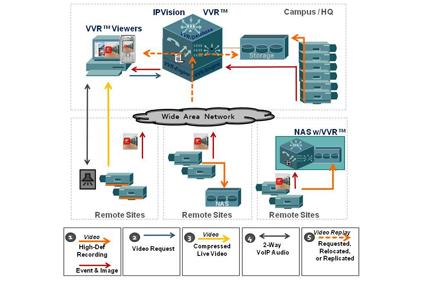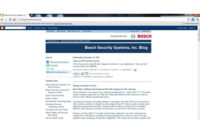
|
| IP cameras and software coexisting with analog cameras can allow myriad storage and retrieval designs by a system integrator. Chart courtesy of Global IPVision. |
A while back, Nate Rice faced the big decision: how and how fast to move to IP-based security video while maintaining and not diminishing his investment in analog cameras and legacy digital video recorders (DVRs). It was not, however, ever a question of continuing to grow and scale up the analog infrastructure.
Rice, the University of South Florida’s engineer for surveillance, shares his convictions and challenges with other security decision makers and their system integrators. Most are not taking a rip out and dump strategy; instead, the migration path is — in most cases —more a matter of coexistence. IP security video cheerleaders such as Fredrik Nilsson, general manager for Axis Communications, Chelmsford, Mass., point out that the vast majority of end users have a major investment in analog.
Significant numbers of analog cameras and complementary products are being sold and installed. And then there are the folks who see value in approaches such as that encouraged by the HDcctv Alliance, an industry association that develops, manages, and promulgates the technical interface specification for what it calls high definition closed-circuit television (HDcctv). Its V1.0 HDcctv standard is derived from the standards adopted by the broadcast industry for digital serial transmission of uncompressed HDTV signals over coaxial cable.
With certain HDcctv supporters, often outside of North America and of interest to dealers and some system integrators providing product to often smaller installations and more comfortable with coax, there still is no doubt that IP-based cameras, components and software comprise the road to the future for many others.
“As analog cameras die, they will be replaced by IP cameras,” Rice says. “And, as DVRs die, they will be replaced by IP encoders. We’re moving into a true open platform program, one that is favorable to our IT department, integrates all brands of cameras on campus into a single best-in-class solution and does not limit us to one manufacturer,” he adds. “With such a system, we will be better able to help provide increased safety for our students and staff and provide a better return on our surveillance system investment, both now and in the future.”
What system integrators call the total cost of ownership of security video systems is an essential element, especially in today’s still sluggish economic environment.
But there is much more to the attraction to IP video for end users and their system integrators.
- Megapixel and high definition cameras are often the door that opens to IP. Some integrators contend that these cameras can do the job of two or three analog cameras. Still, “analog remains an important part” of the security video equation, says Cheryl Bard, product marketing manager with Bosch Security Systems North America, Fairport, N.Y. “There is a lot of talk about megapixel cameras,” she says, but bigger is not necessarily better. “HD is not for every single part of a project.”
- Corporate infrastructure and a friendlier internal information technology (IT) operation, spurred in part by security system integrators that talk their lingo, can cement an IP security video partnership.
- More processing and storage at the edge — in the camera — as well as mobile display of images on laptops and smartphones point to IP as does the emerging hosted, video as a service and “in the cloud” services. Integrators such as Siemens, Diebold, and Navco, who may shy away from classifying the latter advance as outsourcing, see it instead as a way to build a closer, longer relationship with end users. The technology can also provide solutions for short-term security requirements. Boca Raton-based integrator giant ADT Security Services’ John Kenning, who heads up the firm’s commercial side, has an aim to expand monitoring by “bringing together video analytics and access for instantaneous response as a managed service.” Among Kenning’s assignments is investment in software technologies to link everything into a single platform. According to Mark Felberg of Global IP Vision, Tampa, Fla., “Realize that as the IP cameras get smarter, they will be competing with the software companies.”
- There is virtualization, one of today’s darlings of IT. It is a way for IT to better handle its clients’ application and storage needs without dedicating specific servers by fluidly moving and shifting among fewer servers. The scheme has its “green” advantages, since gear must be fed less electricity and chilled air, but a bigger advantage is that system integrators and IT departments can do things or change things more quickly, easily and cheaply. What may have taken 30 days before now could be done in 30 minutes, suggests Anil Karmel of the Los Alamos National Laboratory. Felberg adds that “end users need not care where the server sits. The cameras will see the servers.” He agrees that there needs to be collaboration among security, integrators and IT. “It is a matter of open architecture.”
- Also pushing IP video is a kind of wild card: some enterprises, with retail a pioneering sector, now use or see enhanced value in images captured by security video for analytics and intelligence gathering in support of marketing and merchandizing, among diverse business functions. Such non-security clients can better handle IP-based streaming or retrieval.
- Integration of security video with other security, building and communications systems, in addition, is helped with IP commonality. IP is the way diverse equipment ranging from security and HVAC to telephony talk among themselves.
- For many end users, the most influential element is Internet Protocol itself. Harking back to the mainframe days of IBM, for example, buyers tend to purchase “a safe bet” technology that others already use. But, in this case, the “safe bet” is more of an open systems design which allows for cameras, video management systems and storage devices from myriad vendors.
Nate Rice of USF once had over 700 analog cameras plus scores of DVRs. Over the years, he worked with his providers to maintain a business-benefit coexistence. “A key factor in determining which IP cameras to use besides video quality is reliability and maintenance” is an advance replacement plan, in which replacements are shipped as soon as we report a need for it,” Rice adds.
“There are several reasons why it is important that we migrated to an IP solution,” Rice reports. “First of all, we had to reduce costs.” He points out the challenge of scaling up with DVRs. “With an IP camera, we can simply plug it into the network and allocate storage for that camera. “Equally as important, we also wanted to take advantage of the higher resolution that an IP surveillance solution provides. We wanted to have the availability of megapixel images when needed and that is very difficult to provide in a DVR environment.”
With networked security video and a host system, integrators can also work with clients to provide security at special events. For instance, Navco installed a hosted video surveillance system and IP video from Axis at the PGA Tour’s annual Valero Texas Open in San Antonio.
"In addition to providing a great entertainment experience for our spectators, we also had a fundamental goal to ensure that they have a safe experience while protecting the property that has been entrusted to us by our business partners,” says Tony Piazzi, president and chief executive officer, Golf San Antonio.
The installed cameras were placed at potential areas of loss around the golf course, such as at the Valero Corner Store, as well as near the TPC Apparel Store, admissions booth, refreshment tent, golf cart parking lot and areas where large crowds are expected to gather. Additionally, since most Golf San Antonio personnel worked late into the evening during the tournament, Navco saw the need to have late night coverage over staff parking areas.
Says integrator David McVicker, “Since it would have been completely impractical to run cable all the way back to the recording site, recording to the cloud was the ideal solution for Valero and Golf San Antonio.”
No matter the technology or business challenges of migrating to IP security video, there are expectations of end user buyers. Jim Henry of Henry Bros. Electronics, a turnkey provider of technology-based integrated electronic security solutions, observes that expectations are an important element. He suggests that buyers often expect the technology to do more than it can or they may not have the budget for the expectations. It completed the previously announced merger transaction with Kratos Defense & Security Solutions, Inc.



